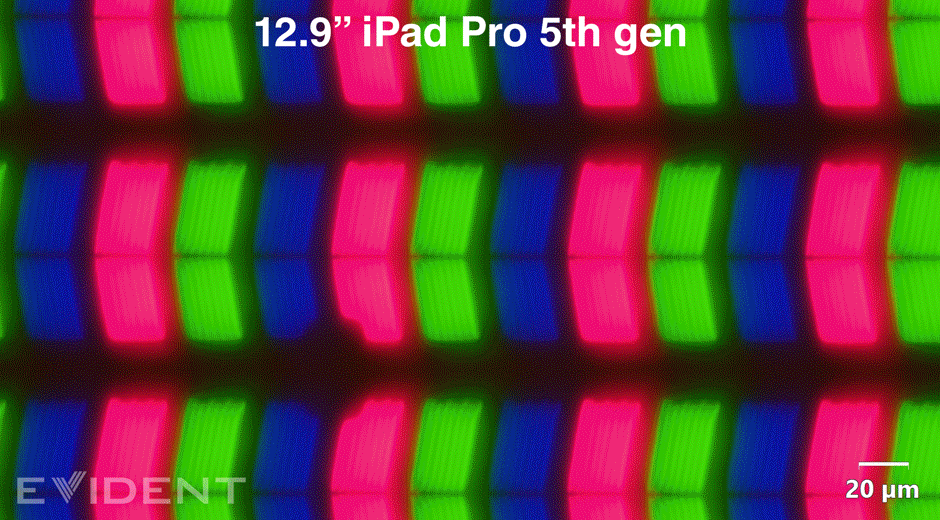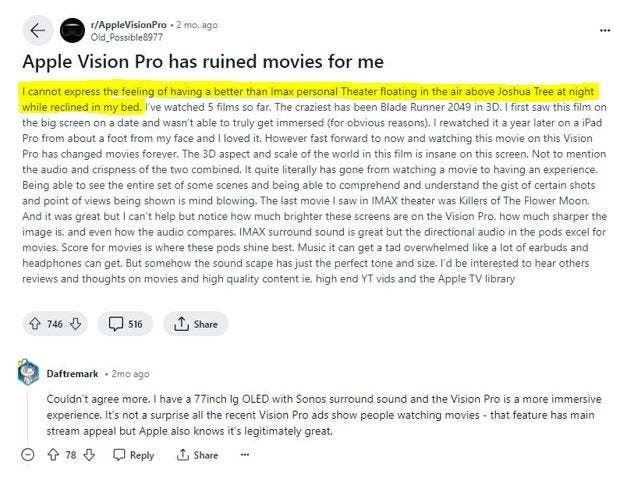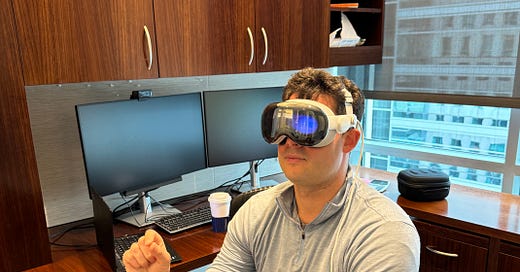"Headphones for Video": Investing in the Apple Vision Pro Ecosystem
UploadVR Editor David Heaney included this quote from Apple Co-Founder Steve Jobs in his recent review of the Vision Pro:
“The fundamental problem here is that headphones are a miraculous thing. You put on a pair of headphones and you get the experience you get with a great pair of speakers.
There’s no such thing as headphones for video. There’s not something I can carry with me that I can put on and it gives me the same experience I get as when I’m watching my 50 inch plasma display at home. Until somebody invents that, you’re going to have these opposing constraints.”
Nineteen years later, Apple's new Vision Pro product boldly aims to fulfill this vision of creating "headphones for video"— a portable, immersive display that can match or exceed the experience of a large screen TV. Having logged 25+ hours in mine so far, I think that Apple has actually done it, and for founders and developers I think the Vision Pro is worth paying attention to.
Despite early software shortcomings, the core use cases that the Vision Pro is targeting—and that startups may build businesses around—already represent huge leaps over the status quo. We are keeping an eye out for early category winners in areas as diverse as business collaboration/productivity, education, mental health, entertainment and more.
For starters: The hardware foundation is incredibly impressive, far surpassing any other consumer AR/VR headset on the market. At the core are the stunning near-4K micro-OLED displays, providing a resolution of 3660 x 3200 pixels per eye. By comparison, the Meta Quest 3, released just months prior, offers 2064 x 2208 pixels per eye.
The difference is noticeable: For the first time in a consumer headset, the "screen-door effect" of visible pixels is practically eliminated. Text is sharp enough to read even at small sizes. High-resolution photos and videos retain their full fidelity. The Vision Pro achieves nearly distortion-free clarity from edge-to-edge, using ambient light sensors to match virtual display brightness to your environment and custom silicon for real-time correction based on eye tracking.

The result is a headset that, for the first time, can truly replace physical displays for both media consumption and productivity. The high $3,500 base price tag no doubt limits the Vision Pro to a niche audience of early adopters. But Apple has never shied away from starting at the high-end. If the Mac, iPod, iPhone and iPad are any indication, today's Vision Pro is merely a preview of a much more affordable and mainstream product line to come.
Favorite Use Case #1: Watching Movies
Movies on the Vision Pro, especially 3D content, was to me a revelatory experience. The sense of scale, depth and immersion feels closer to a high-end cinema than a home TV. I will go see Dune II in theaters with friends because I value how moviegoing is a social experience, but for me, watching the first Dune in 3D on Vision Pro on my couch is a better sensory experience.

Favorite Use Case #2: Working Remotely
On flights, in hotel rooms and at coffee shops, I've found the Vision Pro to be a superior workstation than my laptop when paired with a magic keyboard and trackpad. Limitless virtual screens make it feasible to have a multi-monitor setup materialize anywhere. You can sit up straight, you have perfect lighting and you can enter a flow state much easier.
Favorite Use Case #3: FaceTime
The Vision Pro uses 3D avatars called Personas that allow you to take videos calls while wearing the device. Personas are not great (as evidenced below) but they are good enough for personal calls. My friends all found them uncanny and funny, but they get used to them after five minutes. In the Vision Pro, I can make my friends life-sized and have them be in the room with me, and I can talk to them with no distractions. It is by far the best way I have experienced to feel connected to someone not in the room with you.
Favorite Use Case #4: Memory Capture
The Vision Pro has also completely changed how I capture and consume life's memories. Vision Pro allows you to view photos and videos you capture in 3D (example below from Apple). The technology is not perfect, but I think it’s incredible in the way that it makes you feel like you were back in that moment. Just as we look back wistfully at grainy, low-res digital photos and videos from decades ago, wishing they were higher quality, our future selves may feel the same about today's static captures.
Anyone with an iPhone 15 Pro can capture spatial videos. Even if you don’t get a Vision Pro, I highly recommend that you start capturing memories that way (and also shoot more panoramas). I regret not having this capability to capture my wedding last year. Thankfully, we’re already seeing some cool innovation on converting 2D videos to spatial.
The Negatives
At 600+ grams, the Vision Pro is definitely heavy. I noticed that weight a lot when I first bought it, but after the first five hours or so I got used to it. I wore it for the entirety of two cross country flights last week without issue. Hugo Barra (former Head of Oculus at Meta) makes the point that the device seems purposely overengineered, and there’s good reason to believe it will get lighter (his review here).
The software experience of the device doesn't quite match the polish of the hardware—yet. The 1.0 release of visionOS was quite buggy and rough around the edges. The EyeSight feature, which uses outward-facing cameras to show your eyes to outside observers, works poorly in most lighting conditions. Gaming and fully-immersive VR experiences are extremely limited compared to Meta's Quest ecosystem. Some major media apps like YouTube and Netflix are also missing at launch, hampered by the chicken-and-egg problem of justifying development for a small initial install base (or, perhaps, as a protest to Apple’s App Store policies).
But despite these early software shortcomings, the core use cases that the Vision Pro is targeting—media consumption, productivity and communication—already offer huge leaps over the status quo. Watching a movie in your own personal IMAX, conjuring productivity apps that hover around your Mac, FaceTiming with life-sized friends—these are not just iterative improvements, but category-defining experiences in my view. And the software is getting better. Already, the 1.1 release has made drastic improvements in passthrough (for example, I can now easily read text on my phone). Personas are improved too.
Investing in the visionOS Ecosystem
The initial install base of the Vision Pro is small (Bank of America Analyst Mohan: 400K units in 2024, one million units in 2025). As mentioned above, the price of the device is going to limit the initial audience of the device.
Still, I think the Vision Pro presents a rare greenfield opportunity for developers. Without an entrenched incumbent ecosystem, such as that on existing mobile-app stores, the door is wide open for companies to become the dominant player in a category if they’re developing for visionOS. It’s worth remembering that the iOS App Store was launched in July 2008 and Uber was founded in March 2009. I think it’s worth it to start experimenting with visionOS now and establishing your position for when the lower-cost, higher-production version arrives.
A few of the ideas I'm personally excited by:
Meditation and mindfulness: The immersive environments in Vision Pro are great at helping you tune out notifications and unwanted sensory overload. I think Apple's native mindfulness app is better in the Vision Pro than it's ever been, but there's still room for startups to innovate in this space, such as by offering personalized guided meditations or interactive relaxation experiences.
Focus-enhancing productivity apps: Beyond meditation apps, there's potential for a new generation of productivity tools around the Vision Pro that could help users enter and maintain flow states. These could leverage the headset's sensors to detect when focus is waning and offer intelligent interventions, such as subtle environmental changes or targeted breathing exercises to keep users on track.
Collaborative 3D design tools: The Vision Pro's spatial computing capabilities could revolutionize how designers, architects and engineers work together. Imagine a "GitHub for 3D models," where teams can collaborate in real-time, leave comments and iterate on designs in a shared virtual space. There could also be a new take on virtual whiteboards like Miro and FigJam, allowing for more intuitive and immersive brainstorming sessions.
Immersive education and training: The Vision Pro could be a game-changer for education, allowing students to learn by doing in realistic virtual environments. From medical students practicing surgeries to mechanics repairing virtual engines, the potential for experiential learning is vast. Language learning could also be transformed, with learners conversing with AI characters in virtual foreign cities.
Virtual events and conferences: With the Vision Pro, virtual events could become far more engaging and interactive. Attendees could network in virtual spaces that feel almost as natural as in-person, participate in breakout sessions, engage in interactive skill-building workshops and visit virtual vendor booths. There's an opportunity to build a platform that makes hosting and attending these events seamless and more immersive than current video-conferencing and online-learning solutions.
These ideas just scratch the surface. As developers and entrepreneurs begin to explore this new platform, we’ll be surprised at which visionOS applications break out, just as it was hard to know from day one which iOS apps would be the biggest winners.
Ultimately, the Vision Pro is a foundational device, an ambitious first step towards a new paradigm of personal computing. Just as the original iPhone and iPad were dismissed by some as expensive toys, but went on to redefine entire industries, the Vision Pro lays the groundwork for a future where traditional screens are replaced by software-defined displays we can conjure at will.
It points to a world where the boundaries between "real" and "virtual" dissolve, where any surface can become a screen and any space an infinite workspace. Where face-to-face communication is enhanced by expressive avatars and shared virtual environs. Where our most precious memories are captured not as flat images, but as fully navigable 3D moments in time.
As an investor and someone who just loves technology, I couldn't be more excited about the doors this opens. The Vision Pro not only achieves the long-awaited dream of "headphones for video," but provides a tantalizing peek at so much more.
It’s been said before, but this does feel to me like the turning point where spatial computing begins its inexorable march into the mainstream. Vision Pro is far from the last word in XR headsets. But even in its imperfect, embryonic form, it is the start of an exciting chapter.
For developers, creators and entrepreneurs, it is up to you to help write the story!
The information contained herein is based solely on the opinion of Brandon Gleklen and nothing should be construed as investment advice. This material is provided for informational purposes, and it is not, and may not be relied on in any manner as, legal, tax or investment advice or as an offer to sell or a solicitation of an offer to buy an interest in any fund or investment vehicle managed by Battery Ventures or any other Battery entity. The views expressed here are solely those of the author.
The information above may contain projections or other forward-looking statements regarding future events or expectations. Predictions, opinions and other information discussed in this publication are subject to change continually and without notice of any kind and may no longer be true after the date indicated. Battery Ventures assumes no duty to and does not undertake to update forward-looking statements.




